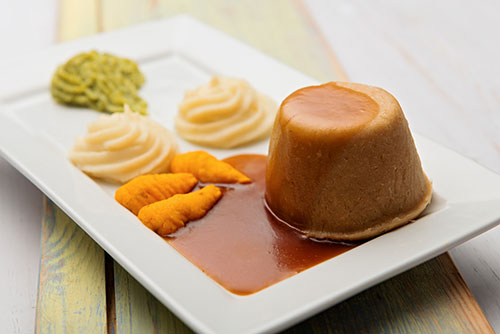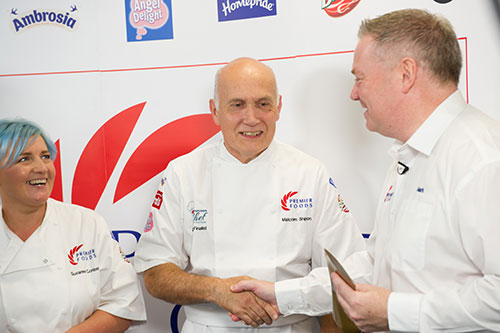Public sector focus: Dysphagia Chef of the Year 2016
At the first Dysphagia Chef of the Year competition, the judges were impressed with Malcolm Shipton's ability to cook a hard-to-recreate pasta dish for those with swallowing difficulties. Katey Pigden reports
The first-ever Dysphagia Chef of the Year competition has been won by Malcolm Shipton of Wren Hall Nursing Home in Selston, Nottinghamshire. The chef, who has worked at the home for nearly a decade, was thrilled to have won. "I was up against some strong competition, but thankfully everything pretty much went to plan," he said.
The winning dish: Malcolm Shipton's herbed chicken cannelloni
His dish of herbed chicken cannelloni with pea purée and tomato impressed the judges and clinched the title. Shipton's meal was designed for those able to eat dishes in the dysphagia texture C descriptor bracket, meaning they can eat a thick purée. Dysphagia, which is a discomfort in swallowing, is a symptom of a number of diseases (see below).
"The role of these caterers is fundamental in ensuring dignity in dining for dysphagia sufferers," said Mark Taylor, foodservice channel controller at Premier Foods. "All of the finalists' dishes were of an exceptional standard."
Shipton rose to the top of the 30 entries in the first competition of its kind, with five candidates earning a place in the final after scoring highly with their competition entries. Entrants had to develop two recipes, one main and one dessert, suitable for a dysphagia sufferer, with both courses costing no more than £5 per person. The recipes were required to meet either C or E descriptors.
Mike Baker's chicken mousseline
In the final, contestants had two hours to produce four covers of either a main course or dessert.
Dishes were judged by Premier Foods' dysphagia catering expert Preston Walker, along with Andy Jones, immediate past chair of the Hospital Caterers Association and Carol Harwood, former training and standards manager at Hertfordshire Catering. "When the judges gave their feedback, I noticed they hadn't said anything negative about my dish," said Shipton. "So I was hoping I would get the title, but couldn't be sure."
After working as a chef in hotels, restaurants and a pub, Shipton took up his first care home role at Wren Hall almost 10 years ago. But it wasn't quite as "cushy" as he anticipated. "I had no idea just how hard it would be," he said. "But it's worth it."
Stephanie Steel's meat and potato pie
"Competitions like this show how far the industry has come in cooking for people who have difficulties eating. I just want to make sure the residents get something different. I tried my dish on them before the competition and it seemed to be a success."
Shipton has previously been honoured for his abilities, having won the National Association of Care Catering Care Cook of the Year award in 2011. But this competition showcased a more specialised side of his talents that benefit a smaller number of residents at Wren Hall.
"We have 15 residents who need a textured diet, so it's important they get a good quality meal like everyone else," he said.
Suzanne Corless's steak and onion steamed pudding
Most of all, the judges were impressed with Shipton's innovative approach when recreating pasta. "I shall never eat cannelloni again without thinking of Malcolm," said Harwood. "I was intrigued how he would manage to try to replicate pasta, but he did a great job."
"It's a real challenge to make pasta dishes suitable for a texture-modified diet," said Walker. "Malcolm's cannelloni not only hit the mark in terms of texture and presentation, but the flavour on the plate was spot on."
Shipton won £1,000 worth of vouchers to be used for kitchen supplies or equipment for his workplace. Wren Hall Nursing Home managing director Anita Astle described the chef as extremely talented, and passionate about the dining experience: "Since joining us in January 2007, Malcolm has transformed our catering by creating great tasting home-cooked food and adding flair to its presentation," she said.
"We support many individuals who need texture-modified foods in order to eat safely. Malcolm has mastered how to maintain the flavour of food and present it in a way that looks appealing. He offers fine-dining experiences at Wren's Nest, giving everyone the chance to dress up and enjoy awesome food. We are so, so proud of him."
Giles Conroy's fresh fruit salad with ice-cream
The finalists and their dishes
Malcolm Shipton
Stephanie Steel, Coed Du Hall - meat and potato pie
Mike Baker, Random Light - chicken mousseline
Suzanne Corless, Random Light - steak and onion steamed pudding
Giles Conroy, Sunrise Senior Living - fresh fruit salad with ice-cream
L to R: Malcolm Shipton, Stephanie Steel, Mike Baker, Suzanne Corless, Giles Conroy
Dysphagia: the facts
Dysphagia is defined as a difficulty or discomfort in swallowing as a symptom of disease. Dementia is one of the most common causes, but other conditions affecting the nervous system, such as a stroke or head injury, can also result in someone developing dysphagia.
Other causes include mouth cancer or oesophageal cancer and gastro-oesophageal reflux disease. Dysphagia can also occur in children as the result of a developmental or learning disability.
Dysphagia affects roughly 8% of the world's population and sufferers can be of any age. However, it is estimated that approximately 60%-75% of people in care homes and 22% of the world's population over the age of 55 are affected by dysphagia and require a texture-modified diet.
Descriptors (A, B, C, etc) detail the types and textures of foods needed by individuals who have swallowing difficulties and who are at risk of choking or aspiration (food or liquid going into their airway). The categories are:
- B: a thin purée
- C: a thick purée
- D: pre-mashed food
- E: fork-mashable food
Why it's worth it
The competition final also involved a presentation from healthcare catering chef James Bull, who has been working alongside the team at Premier Foods. He produced a textured-modified cooked breakfast, followed by a pie and a cheesecake.
"Care home chefs have become very good at lunchtime meals, but breakfast and tea can often get overlooked," he said.
"How something looks can have an impact on someone's appetite, along with flavour and smell. There's not much a talented chef can't do with a piping bag to present food as close to the original shape as possible.
"This attention to detail also raises the standards of people assisting with eating, as they see the effort that has been put in to creating the meal."
Continue reading
You need to be a premium member to view this. Subscribe from just 99p per week.
Already subscribed? Log In

















